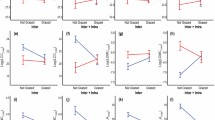Abstract
Water availability is the primary constraint to aboveground net primary productivity (ANPP) in many terrestrial biomes, and it is an ecosystem driver that will be strongly altered by future climate change. Global circulation models predict a shift in precipitation patterns to growing season rainfall events that are larger in size but fewer in number. This “repackaging” of rainfall into large events with long intervening dry intervals could be particularly important in semi-arid grasslands because it is in marked contrast to the frequent but small events that have historically defined this ecosystem. We investigated the effect of more extreme rainfall patterns on ANPP via the use of rainout shelters and paired this experimental manipulation with an investigation of long-term data for ANPP and precipitation. Experimental plots (n = 15) received the long-term (30-year) mean growing season precipitation quantity; however, this amount was distributed as 12, six, or four events applied manually according to seasonal patterns for May–September. The long-term mean (1940–2005) number of rain events in this shortgrass steppe was 14 events, with a minimum of nine events in years of average precipitation. Thus, our experimental treatments pushed this system beyond its recent historical range of variability. Plots receiving fewer, but larger rain events had the highest rates of ANPP (184 ± 38 g m−2), compared to plots receiving more frequent rainfall (105 ± 24 g m−2). ANPP in all experimental plots was greater than long-term mean ANPP for this system (97 g m−2), which may be explained in part by the more even distribution of applied rain events. Soil moisture data indicated that larger events led to greater soil water content and likely permitted moisture penetration to deeper in the soil profile. These results indicate that semi-arid grasslands are capable of responding immediately and substantially to forecast shifts to more extreme precipitation patterns.




Similar content being viewed by others
References
Burke IC, Lauenroth WK, Vinton MA, Hook PB, Kelly RA, Epstein HE, Aguiar MR, Robles MD, Aguilera MO, Murphy KL, Gill RA (1998) Plant-soil interactions in temperate grasslands. Biogeochemistry 42:121–143
Caldwell MM, Dawson TE, Richards JH (1998) Hydraulic lift: consequences of water efflux from the roots of plants. Oecologia 113:151–161
Chesson P, Gebauer RL, Schwinning S, Huntly N, Wiegand K, Ernest MS, Sher A, Novoplansky A, Weltzin JF (2004) Resource pulses, species interactions, and diversity maintenance in arid and semi-arid environments. Oecologia 141:236–253
Churkina G, Running SW (1998) Contrasting climatic controls on the estimated productivity of global terrestrial biomes. Ecosystems 1:206–215
Easterling DR, Meehl GA, Parmesan C, Changnon SA, Karl TR, Mearns LO (2000) Climate extremes: observations, modeling, and impacts. Science 289:2068–2074
Fay PA, Carlisle JD, Knapp AK, Blair JM, Collins SL (2000) Altering rainfall timing and quantity in a mesic grassland ecosystem: design and performance of rainfall manipulation shelters. Ecosystems 3:308–319
Fay PA, Carlisle JD, Knapp AK, Blair JM, Collins SL (2003) Productivity responses to altered rainfall patterns in a C4-dominated grassland. Oecologia 137:245–251
Golluscio RA, Sala OE, Lauenroth WK (1998) Differential use of large summer rainfall events by shrubs and grasses: a manipulative experiment in the Patagonian steppe. Oecologia 115:17–25
Groisman PY, Karl TR, Easterling DR, Knight RW, Jamason PF, Hennessy KJ, Suppiah R, Page CM, Wibig J, Fortuniak K, Razuvaev VN, Douglas A, Forland E, Zhai P (1999) Changes in the probability of heavy precipitation: important indicators of climate change. Clim Change 42:243–283
Harper CW, Blair JM, Fay PA, Knapp AK, Carlisle JD (2005) Increased rainfall variability and reduced rainfall amount decreases soil CO2 flux in a grassland ecosystem. Global Change Biol 11:322–334
Houghton JT, Ding Y, Griggs DJ, Noguer M, van der Linden PJ, Dai X, Maskell K, Johnson CA (2001) Climate change 2001: the scientific basis. Contributions of Working Group 1 to the third assessment report of the Intergovernmental Panel on Climate Change. Cambridge University Press, Cambridge
IPCC (2007) Summary for policymakers. In: Solomon S, Qin D, Manning M, Chen Z, Marquis M, Averyt KB, Tignor M, Miller HL (eds) Climate change 2007: the physical science basis. Contribution of Working Group 1 to the fourth assessment report of the Intergovernmental Panel on Climate Change. Cambridge University Press, Cambridge
Karl TR, Trenberth KE (2003) Modern global climate change. Science 302:1719–1723
Knapp AK, Smith MD (2001) Variation among biomes in temporal dynamics of aboveground primary production. Science 291:481–484
Knapp AK, Fay PA, Blair JM, Collins SL, Smith MD, Carlisle JD, Harper CW, Danner BT, Lett MS, McCarron JK (2002) Rainfall variability, carbon cycling, and plant species diversity in a mesic grassland. Science 298:2202–2205
Lapitan RL, Parton WJ (1996) Seasonal variabilities in the distribution of the microclimatic factors and evapotranspiration in a shortgrass steppe. Agric For Meteorol 79:113–130
Lauenroth WK, Dodd JL, Sims PL (1978) The effects of water- and nitrogen- induced stresses on plant community structure in a semiarid grassland. Oecologia 36:211–222
Lauenroth WK, Sala OE (1992) Long-term forage production of North American shortgrass steppe. Ecol Appl 2:397–403
Lauenroth WK, Bradford JB (2006) Ecohydrology and the partitioning of AET between transpiration and evaporation in a semiarid steppe. Ecosystems 9:756–767
Le Houerou HN, Bingham RL, Skerbek W (1988) Relationship between the variability of primary production and the variability of annual precipitation in world arid lands. J Arid Environ 15:1–8
Loik ME, Breshears DD, Lauenroth WK, Belnap J (2004) Climatology and ecohydrology of precipitation pulses in arid and semiarid ecosystems of the western USA. Oecologia 141:269–281
McAuliffe JR (2003) The atmosphere-biosphere interface: the importance of soils in arid and semi-arid environments. In: Weltzin JF, McPherson GR (eds) Changing precipitation regimes and terrestrial ecosystems: a North American Perspective. University of Arizona Press, Tucson, pp 9–27
Milchunas DG, Lauenroth WK (1995) Inertia in plant community structure: state changes after cessation of nutrient-enrichment stress. Ecol Appl 5:452–458
Mooney HA, Drake BG, Luxmoore RJ, Oechel WC, Pitelka LF (1991) Predicting ecosystem response to elevated CO2 concentrations. BioScience 41:96–104
Nippert JB, Knapp AK, Briggs JM (2006) Intra-annual rainfall variability and grassland productivity: can the past predict the future? Plant Ecol 184:65–74
Novoplansky A, Goldberg DA (2001) Effects of water pulsing on individual performance and competitive hierarchies in plants. J Veg Sci 12:199–208
Noy-Meir I (1973) Desert ecosystems: environment and producers. Annu Rev Ecol Syst 4:23–51
Owensby CE, Ham JM, Knapp AK, Rice CW, Coyne PI, Auen LM (1996) Ecosystem level responses of tallgrass prairie to elevated CO2. In: Koch GW, Mooney HA (eds) Carbon dioxide and terrestrial ecosystems. Academic Press, London, pp 147–162
Parton WJ, Lauenroth WK, Smith FM (1981) Water loss from a shortgrass steppe. Agric Meteorol 24:97–109
Petersen M, Kelly EF, Blecker SW, Yonker CM (1993) Soil survey of central plains experimental range, Weld County, Colorado. USDA Natural Resources Conservation Service
Reynolds JF, Kemp PR, Ogle K, Fernandez RJ (2004) Modifying the ‘pulse-reserve’ paradigm for deserts of North America: precipitation pulses, soil water, and plant responses. Oecologia 141:194–210
Rosenzweig ML (1968) Net primary productivity of terrestrial communities: predictions from climatological data. Am Nat 102:67–74
Ryel RJ, Caldwell MM, Leffler AJ, Yoder CK (2003) Rapid soil moisture recharge to depth by roots in a stand of Artemisia tridentata. Ecology 84:757–764
Sala OE, Lauenroth WK (1982) Small rain events: an ecological role in semi-arid regions. Oecologia 53:301–304
Sala OE, Lauenroth WK, Parton WJ (1982) Plant recovery following prolonged drought in a shortgrass steppe. Agric Meteorol 27:49–58
Sala OE, Lauenroth WK (1985) Root profiles and the ecological effect of light rainshowers in arid and semi-arid regions. Am Mid Nat 114:406–408
Sala OE, Parton WJ, Joyce LA, Lauenroth WK (1988) Primary production of the central grassland region of the United States. Ecology 69:40–45
Sala OE, Lauenroth WK, Parton WJ (1992) Long-term soil water dynamics in the shortgrass steppe. Ecology 73:1175–1181
Schwinning S, Sala OE (2004) Hierarchy of responses to resource pulses in arid and semi-arid ecosystems. Oecologia 141:211–220
Shaw MR, Zavaleta ES, Chiariello NR, Cleland EE, Mooney HA, Field CB (2002) Grassland responses to global environmental changes suppressed by elevated CO2. Science 298:1987–1990
Sher AA, Goldberg DE, Novoplansky A (2004) The effect of mean and variance in resource supply on survival of annuals from Mediterranean and desert environments. Oecologia 141:353–362
Sponseller RA (2007) Precipitation pulses and soil CO2 flux in an Sonoran Desert ecosystem. Global Change Biol 13:426–436
Swemmer AM, Knapp AK, Snyman HA (2007) Intra-seasonal precipitation patterns and above-ground productivity in three perennial grasslands. J Ecol 95:780–788
Walter H (1971) Natural savannahs as a transition to the arid zone. In: Ecology of tropical and subtropical vegetation. Oliver and Boyd, Edinburgh, pp 238–265
Webb WL, Lauenroth WK, Szarek SR, Kinerson RS (1986) Primary production and abiotic controls in forests, grasslands, and desert ecosystems of the United States. Ecology 64:134–151
Weltzin JK, Loik ME, Schwinning S, Williams DG, Fay PA, Haddad BM, Harte J, Huxman TE, Knapp AK, Lin G, Pockman WT, Shaw MR, Small EE, Smith MD, Smith SD, Tissue DT, Zak JC (2003) Assessing the response of terrestrial ecosystems to potential changes in precipitation. BioScience 10:941–952
Williams JW, Jackson ST, Kutzbach JE (2007) Projected distributions of novel and disappearing climates by 2100 AD. Proc Natl Acad Sci USA 104:5738–5742
Wythers KR, Lauenroth WK, Paruelo JM (1999) Bare-soil evaporation under semiarid field conditions. Soil Sci Soc Am J 63:1341–1349
Yahdjian L, Sala OE (2002) A rainout shelter design for intercepting different amounts of rainfall. Oecologia 144:95–101
Acknowledgements
Funding for this research was provided by the Shortgrass Steppe Long Term Ecological Research Program, Konza Prairie Long Term Ecological Research Program, the USDA Managed Ecosystems Program (NRI CREES), and an EPA Science To Achieve Results (STAR) fellowship awarded to J. L. Heisler White. Data for the long-term precipitation analysis were provided by the USDA-ARS CPER. For their generous help and assistance in rainout shelter construction, fieldwork, and execution of the precipitation manipulation experiments in this study, the authors would like to thank Mary Ashby, the CPER support crew, Mark Lindquist, the Shortgrass Steppe Field Crew, Priscilla Baker, and Vanessa Beauchamp. This manuscript was greatly improved by the comments and suggestions of three anonymous reviewers. EPA has not officially endorsed this publication and the views expressed herein may not reflect the views of the EPA.
Author information
Authors and Affiliations
Corresponding author
Additional information
Communicated by Hormoz BassirRad.
Rights and permissions
About this article
Cite this article
Heisler-White, J.L., Knapp, A.K. & Kelly, E.F. Increasing precipitation event size increases aboveground net primary productivity in a semi-arid grassland. Oecologia 158, 129–140 (2008). https://doi.org/10.1007/s00442-008-1116-9
Received:
Accepted:
Published:
Issue Date:
DOI: https://doi.org/10.1007/s00442-008-1116-9




